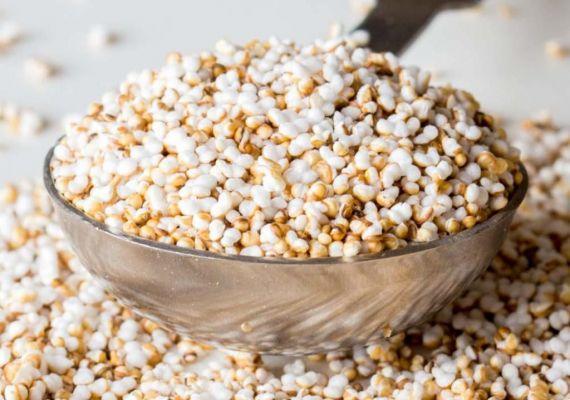
Buckwheat, also known as black wheat, is a pseudo-cereal of the Polygonaceae family. Gluten free but rich in fiber, potassium and phosphorus, it is useful in case of celiac disease, against constipation and as a mood regulator. Let's find out the recipes to prepare it.
What is Buckwheat
Il buckwheat it is not a variety of wheat. Despite the name, therefore, it is not a cereal. Instead, it belongs to the polygonaceae family (such as rhubarb and sorrel), which includes both herbs and small plants.
Insieme a Quinoa, amaranth e chia, pseudocereals, although not grasses (to which true cereals belong), produce small fruits that resemble cereals in shape, size and use, and from which they can be obtained, once ground, gluten-free flours.
The nutritional values of buckwheat
Observing the data reported in the tables INRAN (National Research Institute for Food and Nutrition) it is noted that the hulled buckwheat (wholemeal) has good average nutritional values: 100 grams of buckwheat contains 343 calories .
It is a good source of potassium and phosphorus. It also contains iron and calcium. IS gluten-free and this also makes it accessible from those suffering from intolerances or from celiac disease who can use it in a "gluten free" diet.
Lglycemic index is low, and easily digested. Being the bioabsorbency index very high, it allows to use all the nutrients of which it is composed. Has a moderate content of B vitamins, and vitamin K. It also contains magnesium, mood regulator.
Its content of flavonoids strengthens capillaries and venous walls, and reduces the storage of visceral fat. Studies are in progress that report how the buckwheat be part of the foods that can prevent bowel cancer.
His good fiber content helps intestinal transit. However, it is not recommended in case of colon irritation or chronic constipation.
Ever tried making buckwheat bread?
Uses in the kitchen
In the north of the country the buckwheat is best known for the buckwheat flour inserted in the polenta and taragna and for pizzoccheri. Used in ancient times in cold regions, traces of it can be found in the culinary tradition of much of Europe. In the form of noodles called "Room" buckwheat is a food of macrobiotic cuisine.
In the kitchen you can use the buckwheat both in the form of grains and as flour. It can replace rice, or other grains such as wheat, spelled and barley. Being gluten-free it can replace, both in the form of grain and flour, the traditional cereals that instead contain them.
I whole grains resulting from organic farming can be cooked in a weight of water equal to twice the weight of cereal. It is cooked like brown rice both in a normal pot and in a pressure cooker, with a reduced time. In a normal pot, wholemeal buckwheat (peeled) is cooked in about 20 minutes from boiling the water.
You can also use it not cooked: leaving it to soak for about twelve hours it is suitable for use in salads without cooking.
Briefly toast the bean it makes the buckwheat tastier and allows to enhance its particularity.
La flour it can be used as a substitute for normal gluten-containing flours: it is suitable for celiacs and provides better quality nutritional values than white and refined flours.
The doughs with buckwheat are also suitable for vegan diets: the high starch content makes the dough with buckwheat flour very homogeneous and bound.
La buckwheat flour, added to cornmeal, can be used to make polenta or to cook crepes e crackers.
Buckwheat flakes are also on the market: like all other puffed cereals they are excellent for breakfast, added to yogurt or milk (both animal and vegetable), in the preparation of desserts, muesli and also in the budwig cream of the kousmine method.
Buckwheat leaves: benefits, toxicity, use
Vegan gluten-free pizza with buckwheat flour and rice flour
Ingredients
> 150 gr di buckwheat flour
> 150 grams of rice flour
> 200 ml of water
> 1 sachet of dry yeast
> 1 pinch of salt
> extra virgin olive oil to taste
> tomato sauce
> 200 gr of tofu (you can replace with mozzarisella or other vegetable cheese)
> 200 gr of courgettes
> olive
> sale q.b.
> olio q.b.
Preparation: in a bowl combine the flours with the yeast, add the salt and warm water, the oil and knead. When you have obtained an elastic and not very sticky dough (like any pizza dough), cover the bowl with a cloth and let it rest. In the meantime, prepare the pizza filling: cut the courgettes thin and pass them briefly in a pan in a little hot oil. Add the crumbled tofu and let it flavor. Taste and add salt according to your personal taste.
Roll out the dough on a parchment paper the size of the pan that you will then use to bake the pizza. Sprinkle the surface with a drizzle of tomato puree, just to color the surface of the pizza, and bake at 190 degrees for about 10 minutes. When the pasta starts to dry and swell, take it out of the oven and add the courgettes and tofu. Return to the oven for another 10 minutes at 180 degrees.
variants: you can replace the tofu with mozzarisella. In this case, the cheese should not be added to the zucchini, but put on the pizza after the first batch. Another variant is the white pizza, which is obtained simply by eliminating the tomato sauce.


























